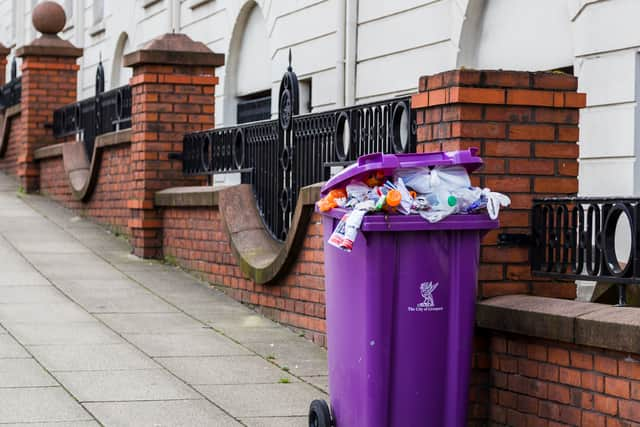City to clamp down on costly misuse of Liverpool’s iconic purple bins
and live on Freeview channel 276
Researchers have been rummaging through Liverpool's rubbish and concluded the city needs to 'get a grip' and what residents are throwing out.
The messy analysis identified a series of incorrect items that are going into the city’s iconic purple bins - or deing dumped beside them.


Advertisement
Hide AdAdvertisement
Hide AdWork is being done across Liverpool and the wider city region in a bid to develop a strategy towards reaching zero waste and therefore reduce the cost of rubbish collection.
A report to Liverpool Council’s neighbourhoods select committee has identified how the city can tighten up its processes to ensure side waste being dumped alongside wheelie bins can become a thing of the past, as well as lowering contamination in recycling.
Currently, Liverpool Council spend almost £9.5m a year collecting waste across the city and an assessment has been undertaken of materials that households leave in their synonymous purple bins.
The report said this work involved physically emptying the contents of the bins and sorting through the findings.
What are Liverpool residents doing wrong?
Advertisement
Hide AdAdvertisement
Hide AdThe messy work found that “too much good” recyclable material is being left in the wrong bin, leading to increased financial and carbon impacts. The report to members said: “There is so much in our residual waste that shouldn’t be there and contamination in our recycling remains a problem.
“In our residual waste, food and materials currently accepted for recycling are a significant issue.” It added: “If we are serious about zero waste, net zero carbon by 2040 and implementing upcoming changes we really have got to get ready starting now.”
A study of food waste by the Merseyside Recycling and Waste Authority (MWRA) found 73% of discarded food waste was avoidable and almost half was still in its packaging.
What can be done to reduce waste?
As a result, a call has been made to develop programmes to change behaviour and ensure the right materials are in the right bins, reducing contamination and increasing the capture of recyclables.
Advertisement
Hide AdAdvertisement
Hide AdThese would “need to focus on smart shopping, avoiding BOGOF offers and helping households plan a weekly menu and shop to it, in order to prevent waste. This is more important than ever, given the growing pressure on household budgets.”
The document, which will go before councillors next week at Liverpool Town Hall, fired a direct warning on the direction of travel needed for standards to improved.
It said: “The data shows we need to provide ongoing information and guidance to residents to encourage them to ‘recycle right.’
“We also need to start to get a grip on our household waste collection policies to move to a position where side waste placed out with the purple bin is no longer tolerated. This will encourage residents to make better use of their recycling bin.”
A survey earlier in the year found that despite millions of pounds being spent tidying up the city, less than half of Liverpool residents asked felt it was clean enough.